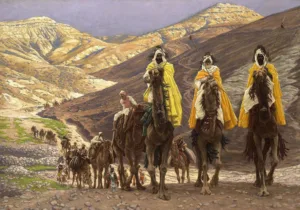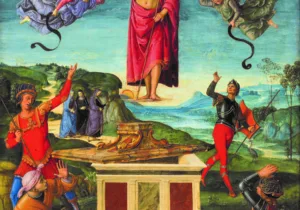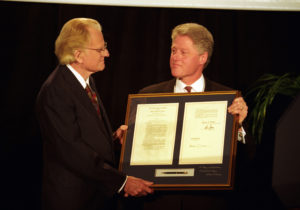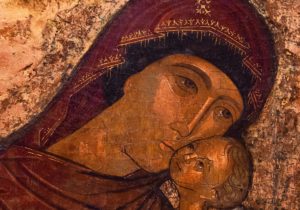As we start to look at this whole Christmas phenomenon, it makes sense to begin with the basics. The first questions any sensible person asks about Christmas are pretty straightforward: What event is this holiday supposed to commemorate, and do we know that it actually happened?
The short answers are that Christmas is a holiday commemorating the birth of Jesus, a Jewish prophet and holy man whose followers came to believe that He was the Son of God about two thousand years ago. And we know about this, despite all the years that have come and gone since, for two reasons. First, the early followers of this mysterious prophet wrote down what they and their community knew about the circumstances of His birth. Those stories are incomplete and the details are fuzzy, but there is more documentary evidence for the birth of Jesus than for many other events that historians confidently treat as factual.
There is another reason we can reasonably conclude that the accounts are, at least in the broadest sense, reliable. The community of followers and witnesses who kept the records and compiled the documentary sources impressed many of their contemporaries as credible people. The rise of the “Jesus movement” in communities of people throughout the area where Jesus lived and in nearby countries depended on the impression that Jesus’ original associates and followers made. To become a “Christian,” as the Jesus followers soon became known, was to risk persecution and ostracism. As we know from non-Christian as well as Christian sources, within a few years of Jesus’ death, both religious and civil leaders in the Roman Empire were punishing Christians with ostracism, torture and death for the crime of believing the message about Jesus that His followers shared. Unless those early followers impressed their contemporaries as credible witnesses, the Jesus movement would have died an early death and would never have become the largest religious community in the history of our species.
The documentary sources for the Christmas story are pretty good by the standards of the ancient world, but are few and short by the standards of our time. Of the four “Gospels” (books in the collection of Christian scriptures known as the “New Testament” that offer narratives about the life and death of Jesus), two provide information about Jesus’ birth. A third offers a theological reflection on the meaning of His birth, and the fourth (the Gospel of Mark) says nothing about Christmas at all.
In Matthew, the Christmas story and its immediate sequel runs from Chapter One, verse one through the end of Chapter Two at verse 23 (or Matthew 1:1-2:23, as this is usually written). In Luke, home of the longest and most elaborate Christmas account, the story runs from Luke 1:5 through 3:38. In the Gospel of John, the opening section (verses 1:1-1:18) offers a kind of meditation on what Christmas is about, and contains some of the most moving and memorable words in the Bible.
(If you invest 20 minutes or so reading these accounts, you will know as much as anybody else in the world about the written history of the birth of Jesus; these are all the written sources from within 100 years or so of His birth that exist.)
The first and, most scholars believe, the oldest version of the story in Matthew starts out rather strangely; it gives a 42-generation genealogical tree for Joseph, “the husband of Mary of whom Jesus was born.” The genealogy links the baby Jesus to the history of the Jewish people, not only connecting Him to Abraham, widely considered the father of the nation, but also to the royal line going back to the heroic, Goliath-killing King David.
That link is important; one of the main themes of the New Testament is that Jesus of Nazareth was The One, the heroic Savior that the Jewish scriptures foretold. From the very earliest days of Christianity, this claim has been one of the central elements of the Christian message, and it has led to a new and distinctively Christian interpretation of the holy books of the Jewish people. It’s an important reason why the Jewish scriptures are included in the Christian Bible: they contain many predictions of a coming Anointed One (“messiah” is an English transliteration of the Hebrew word that means “anointed one”; the word “christ” is a transliteration of the Greek word that means the same thing). The libretto of Handel’s Messiah is essentially a collection of passages from the Jewish scriptures that Christians believe are fulfilled by Jesus’ life and death. The Messiah was predicted, Christians believed, to be a descendant of the Jewish national hero King David and the ancient kings of Judah; He was also going to be born in Bethlehem, the town where David’s family had its roots.
As a literary device, starting a book with a genealogical tree strikes me as an odd choice. This is not the way they teach you to write stories in journalism school; this kind of writing is known as “stepping on the lede.” In the older translations, instead of translating the Greek word “egennasen” as “was the father of,” they used the simpler and more literal “begat.” “Abraham begat Isaac; Isaac begat Jacob,” and so on. There are a lot of passages like this in the Bible, and “the begats,” as these are sometimes called, make some of the dullest reading around.
But the Gospel writers had a purpose in starting the story this way. It’s useful to think of these begats as “rolling the credits” before the main story begins; Luke’s longer Christmas story will end with another family tree for Jesus, this one going all the way back to Adam. So one Gospel rolls the credits at the beginning, the other at the end. Theologically, the point is the same: they connect the story of Christmas and of Jesus to the larger stories of Jewish and human history.
However, the “begats” in Matthew and Luke do raise two problems for readers.
First, the begats trace Jesus’ ancestry through Joseph, but both Matthew and Luke make very clear that Joseph was not Jesus’ biological father. In fact, they both make the startling claim that Jesus did not have a biological father in the ordinary sense, but that God directly intervened so that Mary was still a virgin when she became pregnant and that Jesus is, as the old translations say, “the only begotten Son of God.”
The second problem with the begats is that they aren’t the same. The family tree that Matthew gives for Joseph is rather different from the one that Luke gives. This is slightly disguised because Matthew gives the list in descending order from Abraham down while Luke goes the other way from Jesus up. But if you study the trees closely, you will see that they do not agree. Matthew’s list of the five immediate ancestors of Joseph runs like this: Jacob, Matthan, Eleazar, Eliud, Achim. Luke’s list goes like this: Heli, Matthat, Levi, Melchi, Jannai. The two lists come together on key names like David and Abraham, but otherwise they go their merry and largely independent ways.
What do we make of these problems?
The first problem, why the writers used Joseph’s genealogical tree for a baby not related to him by blood, I think, is relatively simple. Belonging to a royal house in those days meant being acknowledged by the head of the house. This is how it worked for the Caesars. The Caesar we know as Augustus was the adopted son of Julius Caesar; his successor Tiberius was also adopted, and Tiberius in turn went on to adopt Caligula. More broadly, we should remember that paternity was a different thing in a pre-scientific age. In a world without DNA tests, if your mother’s husband acknowledged you as his son or his daughter, that was it. End of story. Joseph acknowledged Jesus as his son; Jesus was of the House of David, and His claim to the throne of David was as good as Tiberius Caesar’s claim to the throne of his adopted father Augustus. That at least is how it must have seemed to the Gospel writers.
The second problem is trickier. The Bible is a collection of unusual, even unique books, and most Christians historically have seen them as inspired by God. As St. Paul puts it in the second of the two letters addressed to Timothy in the Christian Bible, “All scripture is given by inspiration of God, and is profitable for doctrine, for reproof, for correction, for instruction in righteousness: That the man of God may be perfect, thoroughly furnished unto all good works” (2 Tim 3:16 KJV).
That, presumably, means that the holy books are accurate: Would an omniscient God inspire a writer to make factual mistakes? If, as some Christians hold, the Bible is a divinely inspired book without a single error or contradiction, what is Joseph doing with two incompatible family trees?
Readers have been scratching their heads over this issue for almost two thousand years, and many theories have been advanced to account for the discrepancy. There are plenty of writers who have come up with various ingenious solutions as to how these family trees can be reconciled. Far be it from me to say that they can’t be, but for a humble lay blogger like myself a lot of this effort seems beside the point. It’s enough to see the literary point of what’s happening.
Regardless of the details, both Matthew and Luke think it’s extremely important that Jesus was a Jew and that the story of Jesus is part of the story of God’s encounter with the Jewish people. Gentile Christians going back to the first century AD have often wished this wasn’t so. In ancient times, various Greek and Roman cults grew up that detached the figure of Jesus from this Jewish context and turned him into something more like the mythical heroes and deities of the mystery religions that were so popular at the time. More recently, the Nazis in particular hated the idea of Jesus being a Jew, and some of them went so far as to invent an “Aryan Christianity” with an Aryan Christ. The Nazis were picking up on a kind of anti-Semitism that flourished in the first and second centuries after Christ as theological writers like Marcion argued that the Jewish God of the Old Testament had nothing to do with the much higher, more noble, and philosophically acceptable deity proclaimed by Jesus.
That is not how the Gospel writers saw it, and these family trees are there to make sure that the Jesus story stays grounded in the story of the Jewish people. That reality mattered more to whoever finally assembled the Gospels into their current form than the genealogical details, and this should be the takeaway for those of us reading the story now.
There are two messages we should get from the begats: First, that Jesus was Jewish and His story needs to be seen as the continuation of the Jewish religious story that starts with God’s promises to Abraham and even further on back to the creation of the world.
Second, the life of Jesus should be seen as part of the grounded world of history and not a free-floating myth. It’s important to the Gospel writers that we approach the Christmas story as a historical event with spiritual significance rather than as a set of pretty fables. They are claiming that all this really happened, and to understand the Christmas story as Christians historically have experienced it, we have to acknowledge this claim.
Luke makes this even more clear in the way he starts his Gospel; he prefaces the story by saying that he’s writing his account after a thorough investigation. (See Luke 1:1-4.) Luke is so determined to stake a claim to writing as a historian that his language changes; the Greek in which these verses are written is much more like the classic Greek of great historians like Thucydides and Herodotus than like the casual and loose Greek in which most of the New Testament is written.
By historian, though, Luke didn’t mean what we mean today by a historian. We have professional historians who work in a tradition of investigation and archival research that has been developing for more than 200 years. There are accepted requirements for documentation and citation, and historians today have both the comfort and the burden of knowing that their work will be checked and examined by many others.
Some of the world’s greatest and most influential historical writers lived in the ancient world, but in an age without printing, video recording, Wikipedia, freedom of information laws, and taxpayer-supported archives open to professional investigators, they worked under quite different conditions. A good historian spoke to as many different eyewitnesses as possible, consulted whatever written sources were available, and used reason and common sense to bridge the inevitable gaps in the record. Written records were both sketchier and harder to come by in those days, and it was also much harder to travel around. State papers were often considered the private property of the people who produced them, and the modern concept of a repository for documents that are cataloged and kept orderly and available for researchers was unheard of. The greatest Greek and Roman historians did not even try to present word for word accounts of important speeches; they supplemented what they and other eyewitnesses remembered of important speeches by putting what they felt were the appropriate words into their characters’ mouths.
Luke, like the other Gospel writers, lived in a world in which “best practice” for historians was different from what we are used to today, and to read the Gospels or indeed any other ancient historical document as if it had been written by a modern professional historian is to miss much of what the authors intended for us to know. In point of fact, by modern standards, the Gospel writers—because of the supreme importance they attached to the spoken words of a man they believed to be the Son of God—went to much greater lengths to preserve the actual words of Christ than, for example, their pagan contemporary historians were interested in preserving the actual words of Augustus Caesar. Nevertheless, historical writers in an age where written sources were rare and video and sound recordings non-existent necessarily saw their job in a different way than historians do today.
And there is something else to remember: in a world in which every book had to be laboriously copied out by hand, length mattered. Parchment was expensive; books were rare. Every chapter, every line, every word put into a document made that document more expensive to preserve and distribute, and increased the chance that copying errors would creep in.
Length also mattered because books were written then to be performed rather than read silently as we now do. In those days, writers wrote without punctuation marks or even breaks between words; readings were generally communal. Books were recited and silent, solitary reading was extremely unusual. The letters written on a page worked more like notes in sheet music today; unusually gifted and educated people could “hear them in their heads,” but books were primarily written as aids to public performance rather than as instruments of private study.
Today, we see 700- and 800-page biographies and memoirs being produced about, by the world’s standards, some pretty insignificant lives. (In God’s eyes, of course, there are no ‘insignificant lives’). In Greco-Roman times, it was extremely rare to have a book-length biography of a single person, however important. The life of Jesus is better attested by more contemporary writers at greater length than the life of just about anybody else from this time period; we have more evidence about what He said and did than we have about any of the other famous people of His era. Even so, by the standards of a modern political or business leader, the written records we have about His life seem fragmentary and scant.
The historians of the ancient world were concerned with explaining the meaning of important events. To assemble the massive and detailed factual information that a standard biography now features was utterly beyond their capacity; they looked for the telling detail and the illuminating moment because that is what they had the ability to record. We see this in the way the Gospels, unlike modern biographies that tell a single connected narrative from cradle to grave, concentrate on a handful of key episodes in the life of Jesus. The writers selected details ruthlessly because they couldn’t write 800-page biographies with 200 pages more of bibliographies and appendices. They worked with the records and the sources they had, and they used the methods of historical investigation they knew and that were accepted by the educated people of the time.
Most Christians, and I include myself in that number, believe that both the Jewish and the Greek books of the Bible were inspired by God. How to reconcile that faith with the reality that these are also human documents, written by people whose ideas and understanding were shaped by the intellectual climate around them and the age in which they lived, is a complicated question. I do not pretend to have all the answers to that; but just as I can believe that Jesus of Nazareth, a human being like the rest of us, was also the Son of God with a unique relationship to the creator of the world, I can believe that divine inspiration, working in and through the consciousness of limited, human authors, produced documents through which people today can hear the actual Word of God. The union of the eternal and the temporal, of ultimate truth and reality with day-to-day human life, is the central mystery of the Christmas story. It is not surprising that the texts through which we learn of this story are shaped by and reflect that same meeting of the world of timeless truth and the world of history and change. The Bible reflects and expresses the encounter of humanity with God, the union of time and eternity, and all the mysteries and paradoxes of that encounter are reflected in the text as we read it today.
The Christmas story may or may not be real history; that is a question each reader has to answer on his or her own, based on a mix of factual information, personal experience, faith and intellectual conviction. We will be looking both at the story of Christmas and its meaning as these posts continue. But for now, this much should be clear. Those who first researched the story and wrote it down worked very hard to hammer two points home: that the Christmas story is real, and that it is really Jewish.
They used all the literary and historical techniques available to them to make these points as strongly as they knew how, and it is worth remembering at this point that few other events in the ancient world have as much evidence behind them as the Christmas story. The infancy narratives in Matthew and Luke are not the kind of history a modern historian would write, but the people who wrote them knew the difference between history and mythology, and they did what they could to ground the Christmas story in the real world.







 Sponsor a student for Christianity & National Security 2024
Sponsor a student for Christianity & National Security 2024